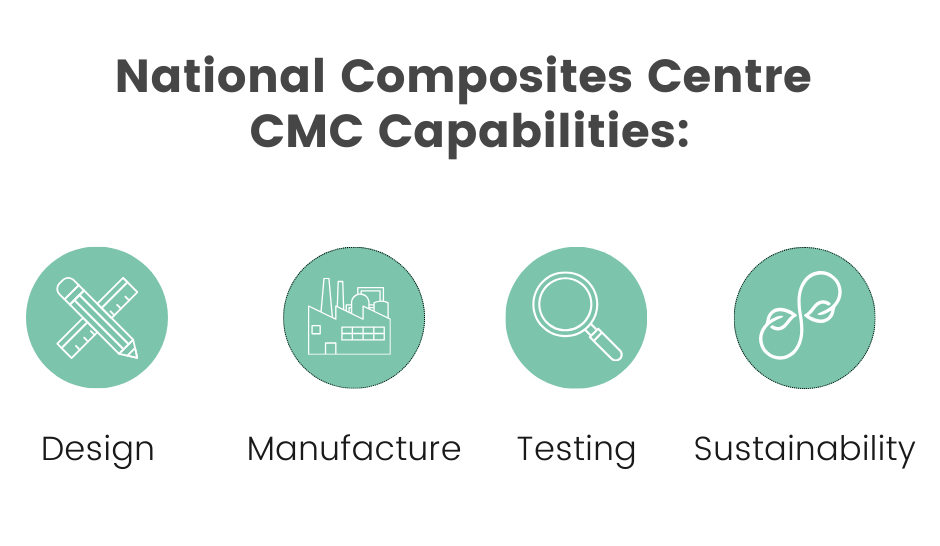News
The NCC is pleased to announce support of the UK Atomic Energy Authority (UKAEA) on the HASTE-F programme, sharing knowledge and expertise in the application of SiC/SiC in future fusion power reactors.
With the global market for Ceramic Matrix Composites (CMC) estimated to grow to USD22 billion by 2030, the National Composites Centre (NCC) continues to invest in the development of CMC capabilities to meet an ever-increasing customer demand associated with extreme environments such as energy, defence, space, and aerospace.
The NCC has been building its CMC capability by investing in high temperature processing equipment and adapting its current world class composite manufacturing techniques to be compatible with ceramics. The NCC’s dedicated CMC development facility now includes advanced material layup techniques (including digital and automated layup), high temperature furnaces, failure modelling, component inspection, materials testing and expertise in component design for CMCs.
Recent advancements in digital manufacturing techniques of CMCs are helping transform the marketplace with the ability to minimise material waste and getting parts ‘right, first time’ to dramatically reduce development costs, allowing the UK to exploit the performance, efficiency and sustainability benefits CMCs have to offer.

Benefits:
Silicon carbide based (SiC)
Realising nuclear fusion, designing hypersonic sonic vehicles, and achieving net zero aviation are the leading engineering challenges facing the UK’s energy, defence, space and aerospace sectors. Operating in these extreme environments demands state-of-the-art material systems capable of enduring high temperature, radiation exposure and oxidation.
Silicon carbide CMCs are capable of operating temperatures as high as 1600℃ and have excellent radiation resistance. They have been identified as viable candidates to withstand the conditions within a future fusion reactor. It’s been calculated that a future fusion reactor exhibits a +200% energy yield if SiC/SiC CMCs are deployed instead of steels.
The first-generation fusion grade SiC/SiC CMC material was created at the NCC in collaboration with the UK Atomic Energy Authority. Initial estimates show that the process costs up to 80% less than the conventional method of chemical vapour infiltration and is up to six times faster. The NCC continues to pioneer the industrialisation of UK SiC/SiC design, modelling, manufacturing, and technology capabilities that will feed into the fusion industry, making it more scalable, accessible, and cost effective.
Ultra-high temperature
Ultra-high temperature ceramic matrix composites are a category of materials exhibiting the some of the highest temperature melting points. The materials are designed to operate in extreme environments where conventional monolithic ceramics and metals would fail due to extreme heat. The materials often comprise of carbon fibre with a matrix system consisting of ultra-high temperature ceramic particles such as HfB2 and ZrB2. They are deployed in applications such as rocket nozzles, leading edges of hypersonic vehicles and as heat shields for space exploration. Interest in the materials has heightened in recent years as interest in hypersonic flight has intensified. The NCC has developed numerous innovative manufacturing processes in collaboration with the UK’s defence and space sectors which it is currently upscaling.
Oxide based (Ox)
CMCs are beginning to transform the aviation industry following the formation of high scale manufacturing plants in the US. As a UK leader in CMC manufacture, the NCC’s work is helping build a secure and affordable national supply chain.
Oxide based CMCs are seen as candidate materials to replace nickel based super alloys within aerospace engines. Ox-ox CMCs are stable up to 1100℃ (whereas nickel based super alloys up to 800℃) and are roughly 1/3rd of the weight of their metallic counterparts.
The NCC has been developing the capability to manufacture large complex component prototype oxide-based CMCs since 2018, and we continue to create numerous complex geometry prototype components for the aerospace and defence sectors.